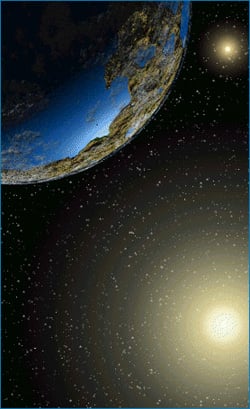Look up into the night sky and you'll see stars dozens and even hundreds of light-years away. It's hard to know where are the closest and which are the most distant stars because the brightest stars can be seen far away. Astronomers have measured the distance to most of the stars you can see with your unaided eye to determine which are the nearest stars.
Here is a list of the 20 closest star systems and their distance in light-years. Some of these have multiple stars, but they're part of the same system.
- Alpha Centauri - 4.2
- Barnard's Star - 5.9
- Wolf 359 - 7.8
- Lalande 21185 - 8.3
- Sirius - 8.6
- Luyten 726-8 - 8.7
- Ross 154 - 9.7
- Ross 248 - 10.3
- Epsilon Eridani - 10.5
- Lacaille 9352 - 10.7
- Ross 128 - 10.9
- EZ Aquarii - 11.3
- Procyon - 11.4
- 61 Cygni - 11.4
- Struve 2398 - 11.5
- Groombridge 34 - 11.6
- Epison Indi - 11.8
- Dx Carncri - 11.8
- Tau Ceti - 11.9
- GJ 106 - 11.9
So how do astronomers measure the distance to stars? They use a technique called parallax. Do a little experiment here. Hold one of your arms out at length and put your thumb up so that it's beside some distant reference object. Now take turns opening and closing each eye. Notice how your thumb seems to jump back and forth as you switch eyes? That's the parallax method.
To measure the distance to stars, you measure the angle to a star when the Earth is one side of its orbit; say in the summer. Then you wait 6 month, until the Earth has moved to the opposite side of its orbit, and then measure the angle to the star compared to some distant reference object. If the star is close, the angle will be measurable, and the distance can be calculated.
You can only really measure the distance to the nearest stars this way. This technique only works to about 100 light-years.
We have written many articles about stars here on Universe Today. Here's an article about how
new stars were discovered
using the parallax method, and a newly discovered star that
could be the third closest
.
If you'd like more information on stars, check out
Hubblesite's News Releases about Stars
, and here's the
stars and galaxies homepage
.
We have recorded several episodes of Astronomy Cast about stars. Here are two that you might find helpful:
Episode 12: Where Do Baby Stars Come From
, and
Episode 13: Where Do Stars Go When they Die
?
 Universe Today
Universe Today
